The Mighty Handful: An audio/visual history
BACKGROUND
Let’s begin with a quote from The New Grove Dictionary of Music:
Until the 18th century, Russian music developed (insofar as it can be said to have developed at all) in almost complete isolation.
This is a remarkable statement! Why was Russia so isolated?

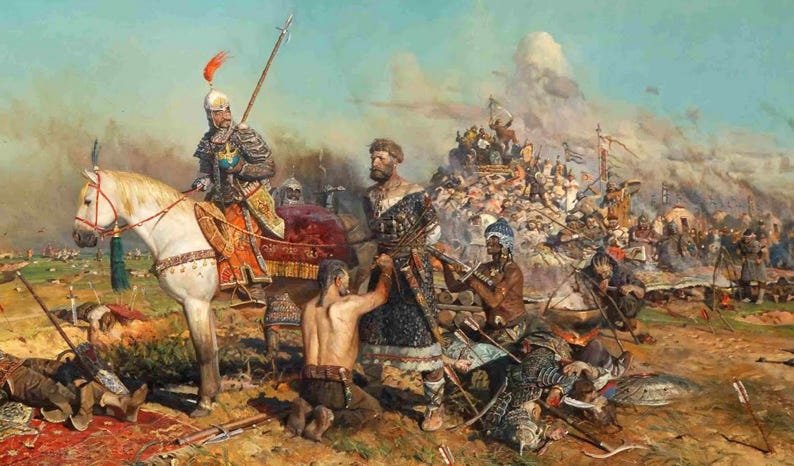
1) Russia had been converted to the Greek Orthodox branch of Christianity, and therefore the religious and cultural influence of Constantinople, not Rome, had predominated.
2) The Mongol invasions and conquests around 1240 had kept Russia under Asian domination for about 250 years, until 1480, when a Grand Duke of Muscovy, Ivan III, was able to throw off the Mongol overlordship.
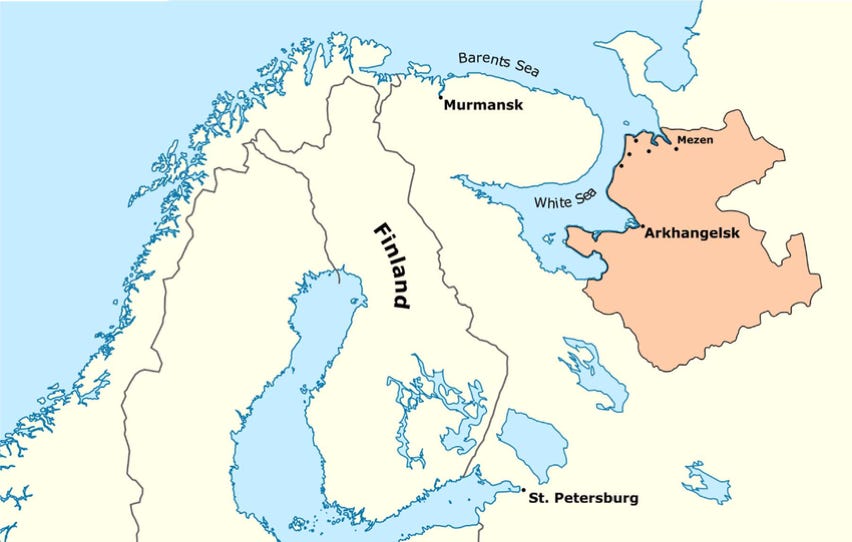

Arkhangelsk
3) Russian geography, especially the lack of warm-water or ice-free seaports, had made commerce and communication with the west difficult.

Peter the Great oversaw the modernization and Westernization of Russia. He “broke open the windows to the West.” His travels through Europe in the 1690s (often incognito) convinced him that Russia was far behind the nation-states of Western Europe, and upon his arrival back in Russia in 1698 he instituted a number of reforms and issued decrees. He:
1) Required all gentry to put their sons in school
2) sent many abroad to study
3) simplified the Russian alphabet
4) edited the first Russian newspaper
5) forbade the beard in Russia
6) required nobles to wear Western dress
7) forbade any person to kneel before him in the streets, or to cover himself with mud in honor of his sovereign.
—and many more. There was an influx of Western European workers, architects, engineers, painters, and yes, MUSICIANS, especially Italian musicians. This is when we can begin to see the beginnings of a musical culture in Russia.
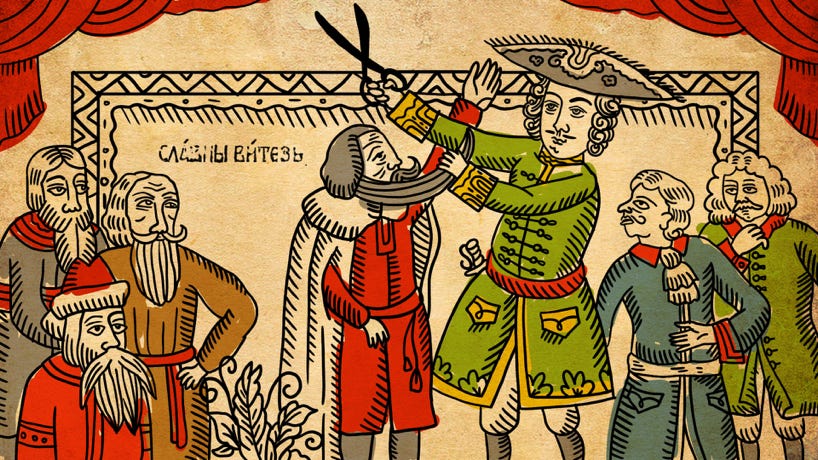
Peter the Great (he was 6 ft. 8 inches in height) cutting off beards
BEGINNINGS
Were there any Russian composers of note prior to the Romantic period (for example, contemporaries of Mozart and Beethoven)?
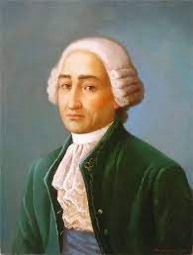
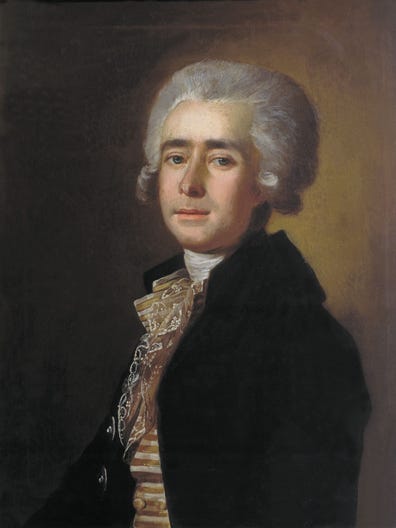
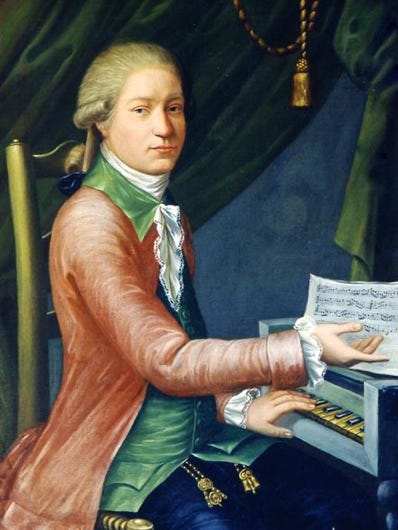
Maxim Berezovsky (1745-77)
Dmitri Bortniansky (1751-1825)
Yevstigney Fomin (1761-1800)
The answer is YES! However, in the USA we don’t hear much of their music. What did they have in common? All three studied in Italy, because there was no place in Russia to get training. Hence, their music sounds very much like European Classical music of the time. Maxim Berezovsky was one of the first Russian (he was actually Ukranian) composers to be recognized outside of Russia and the first one to compose an opera. Offered here (below) is his Symphony No. 1 from the early 1770s, performed by the Kiev Symphony, with Luigi Gaggero conducting—and what energetic conducting!! Does the piece sound “Russian” in any way?
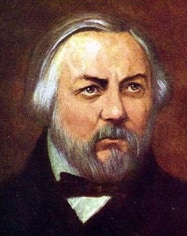
Mikhail Glinka ( 1804-57)
The “Father of Russian Music”
The career of Glinka started in a similar way as the three composers featured above: Glinka went to Italy in 1830 to study composition, and he remained there fro three years, studying counterpoint, composition, and meeting major Italian composers such as Bellini. He tried immersing himself in the Italian tradition, but by the end of his stay he wrote the following:
I could not sincerely be Italian. A longing for my own country led
Me gradually to the idea of writing in a Russian manner.
In the following year he began composing his first opera: A Life for the Tsar. A critical date in Russian Music occurred on December 9, 1836: the first performance of A Life for the Tsar. It created quite a stir and was a sensational success. Within Russia it was the most performed of all native operas until the 1917 Revolution. It was even suggested that the melody of the final scene should become the new Soviet national anthem: “Slavia” (see video below).
Glinka: Overture to A Life for the Tsar (ending), with the Mikhailovsky Theater Orchestra
Glinka: “Slavia” chorus from A Life for the Tsar
Glinka composed one more opera: Russian and Ludmilla (1842). Here is the brilliant Overture
Glinka composed Kamarinskaya in 1848. Kamarinskaya is a traditional Russian folk dance: a quick dance tune with endless variations, which is traditionally played by a fiddler, a balalaika, and/or a concertina (similar to a small accordion). This was Glinka’s first orchestral work based entirely on Russian folk song. Can you tell that the music is beginning to sound more “Russian”?
Glinka: Kamarinskaya (excerpt)
THE MID-CENTURY SPLIT
In the mid-1850s going into the 1860s, a divide occurred in Russian music. One faction was led by the brilliant pianist and composer Anton Rubenstein, who became convinced after his studies in Germany (not Italy!) that higher musical education was a prerequisite for the building of a musical culture in Russia. Rubenstein founded the St. Petersburg Conservatory of Music in 1862. Opposed to that was the group that would soon be called “The Mighty Handful” or “The Five”, and the music critic Vladimir Stasov, who wrote that composers, “by borrowing from their own native traditions, might create a truly national art that could match Europe's with its high artistic standards and originality.” The composer Mily Balakirev was the leader of “The Mighty Handful”(Balakirev, Cui, Borodin, Mussorgsky, and Rimsky-Korsakov), and the group shunned academic, “dry” and “pedantic” musical training (and were mostly self-taught themselves). Thus formed the New Russian School in one corner and the “Conservatives” (think: Conservatory). The battle was on!
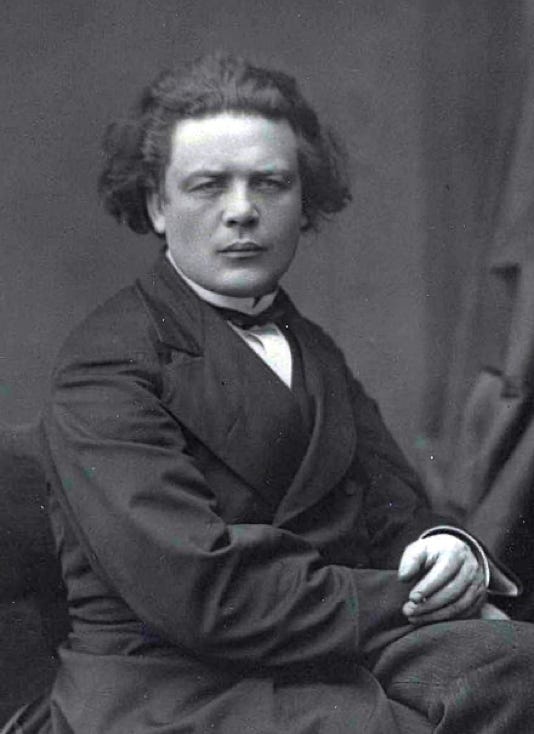
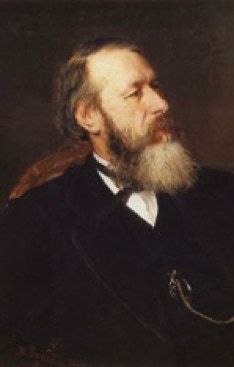

Anton Rubenstein (1829- 1894)
Vladimir Stasov (1824-1906)
Mily Balakirev (1837-1910)
THE AIMS, GOALS, AND CHARACTERISTICS OF “THE MIGHTY HANDFUL”
- Absence of preconception and blind faith
- Independence of thought and skepticism towards musical creations of the past
- Give credence to NO tradition
- Say NO to academic training
- Reject all academicism and pedantry
- Strive for national character
- Use folk music as the basis for creating Russian “Art” music
- Pronounced ‘Oriental’ or “Eastern” element
- Extreme inclinations towards program music
THE MUSIC OF “THE MIGHTY HANDFUL”
Balakirev: Overture on Three Russian Themes (1858)
The Overture on Three Russian Themes was the first purely orchestral work of Balakirev to be based on Russian folk songs. It is a remarkable composition for a young man in his early twenties. The work is the earliest example of the successful reconciliation of Russian folk materials with sonata structure, something which Balakirev’s predecessor Glinka had never achieved. The Russian folks songs used in this wonderful selection would find their way into the finale of Tchaikovsky’s Symphony No. 4 as well as Stravinsky’s Petrouchka.
Borodin: Polovetsian Dances from Prince Igor (unfinished at composer’s death)
Borodin’s busy career as a chemist (he made important contributions to organic chemistry) and professor left him little time to compose, and his relatively early death from sudden heart failure at the age of 53 left his only opera Prince Igor incomplete. The Polovetsian Dances from the opera were
finished and remain very popular around the world. Borodin and Rimsky-Korsakov spearheaded the Mighty Handful goal of incorporating exoticism, Orientalism and Eastern timbres into their works, and the Polovetsian Dances are an excellent example of these qualities.
Borodin: In the Steppes of Central Asia (1880)
In the Steppes of Central Asia portrays an encounter between Russians and Central Asians in the vast steppe of Central Asia. A caravan of Central Asians moves through the desert, guarded by Russian soldiers. The work begins with a theme symbolizing the Russians, followed by an intricate, eastern melody played on the English horn, representing the Central Asians. These melodies intertwine contrapuntally as the piece progresses. Borodin introduces a "traveling" theme in pizzicato, evoking the steady hoofbeats of horses and camels. In the final moments, only the Russian theme remains.
Mussorgsky: Lullaby from Songs and Dances of Death (mid-1870s)
Modest Mussorgsky was the most progressive of the Mighty Handful composers, and his music had a powerful on numerous composers, including Debussy, Ravel, Stravinsky, Shostakovich, and Bartok. His song cycle Songs and Dances of Death was composed for voice and piano (orchestrated by Glazunov and Rimsky-Korsakov after Mussorgsky’s death) in the mid-1870s. Lullaby (song No. 1) tells the following story: A mother in a peasant hut cradles her sick child, who grows more feverish. Death appears, and tries to console the frantic mother and her child. The mother's lines in the song are marked by agitato markings and sixteenth-note rests indicating her fear and panic. In contrast, Death's lines are slow and deliberate, marked with lento and tranquillo markings. Each of Death's interjections ends with a "lullaby" motive directed to the child. Eventually, the mother accepts her child's fate, and allows Death to rock the child to eternal sleep. This is very different music than Pictures at an Exhibition!
Rimsky-Korsakov: Scheherazade (excerpt from Mvt. 3) (1888)
Rimsky-Korsakov was the most successful and famous of the Mighty Handful, and had the most prolific career and longest life. His mastery of orchestration and technical skill, as well as his teaching abilities (his students included Stravinsky, Prokofiev, Glazunov, Respighi, and Arensky) guaranteed this composer a place in the pantheon of master composers of the late Romantic period. His most beloved work may very well be Scheherazade, which once again (like Borodin) makes use of exotic themes and Eastern effects. In 1910 the Russian impresario Serge Diaghilev turned Scheherazade into a Ballet for the Ballets Russes (the same year as Stravinsky’s Firebird). The choreography in this video is from the original Ballets Russes. Enjoy!